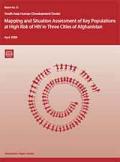Publications - Released in 2008
As yet, little is known about the HIV epidemic status and potential in Afghanistan. The country seems to be at an early epidemic phase with low HIV prevalence, but there are a number of underlying vulnerability factors that could lead to the conditions for epidemic expansion, including drug trafficking, the post-conflict situation with displacement of populations, a fledgling health care system, and a low level of knowledge and awareness about HIV/AIDS. As in other parts of central and south Asia, the most important proximate determinants of the scale and distribution of an HIV epidemic in Afghanistan will be the size and characteristics of high risk networks involving injecting drug users (IDUs), female sex workers (FSWs) and men who have sex with men (MSM) who are at high risk (i.e., have high numbers of sexual partners).
Assessments from elsewhere in central Asia indicate an explosive growth in injecting drug use and commercial sex work throughout the region, concurrent epidemics of sexually transmitted infections (STIs), and economic and political migration. As yet, little information is known about the size, distribution, and characteristics of IDU and sex worker sub-populations in Afghanistan. Therefore, the World Bank (WB) agreed with the Ministry of Public Health (MOPH) to contract with the University of Manitoba (UM) to conduct an assessment of these three key, high risk populations in three cities of Afghanistan: Mazār-i-Sharif, Jalalabad, and Kabul.
Downloads
Organizations
- World Bank






